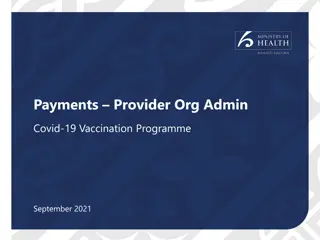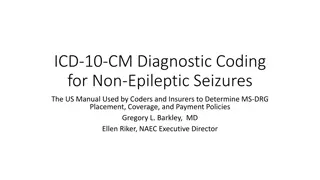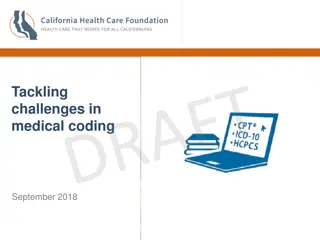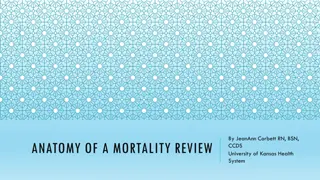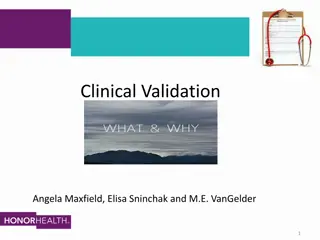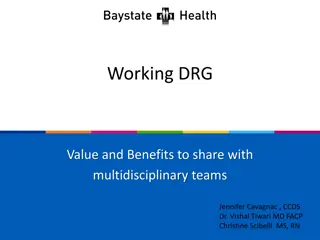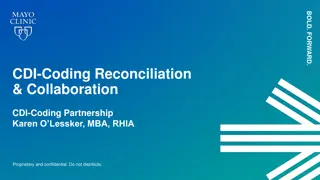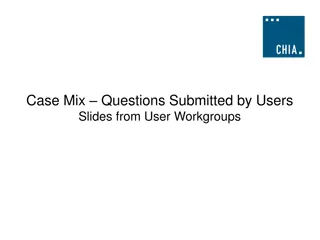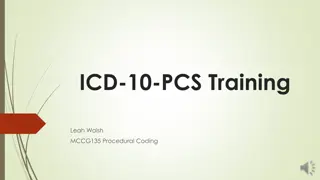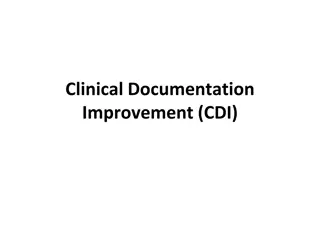The Impact of Inpatient Quality Coding Beyond DRG Payment
Inpatient quality coding goes beyond DRG payment and affects various aspects such as publicly reported quality scores, mortalities, readmissions, infections, and more. Initiatives like CORE Quality Measures and Patient Safety Indicators play a crucial role in improving patient outcomes and reducing complications. Understanding the broader implications of coding can help organizations enhance their performance and patient care delivery.
Download Presentation

Please find below an Image/Link to download the presentation.
The content on the website is provided AS IS for your information and personal use only. It may not be sold, licensed, or shared on other websites without obtaining consent from the author. Download presentation by click this link. If you encounter any issues during the download, it is possible that the publisher has removed the file from their server.
E N D
Presentation Transcript
Inpatient Quality Coding It s Not Just About What you Get Paid Denise LaRue, RHIA, CCS Inpatient Quality Coding Auditor Sarasota Memorial Health Care System
Sarasota Memorial Health Care System Regional Public Hospital with 806 beds plus: 7 Urgent Care Centers, 6 Health Care Centers, 2 Emergency Rooms, Same Day Surgery Center Trauma Center, Acute Inpatient Rehabilitation Unit, Psychiatric Unit
Objectives Create a better understanding how Inpatient coding affects an organization beyond the DRG payment Ways to improve coding through documentation, education, and collaboration
So what else does coding affect ? Publicly Reported Quality Scores Mortalities, Readmissions, Infections, Value Based Purchasing Magnet Status Governmental Scrutiny - OIG, Strike Force, MAC, State level, etc.
CORE Quality Measures National standards of care and treatment for common conditions, in which improve patient outcomes and reduce complications. A total of 32 measures, but only a few are codeable issues Created as a collaborative effort between multiple groups including CMS, and National Quality Forum (NQF)
CORE Measures Sepsis Influenza vaccination Obstetrical Elective deliveries any delivery between 37 and 39 weeks Elective Cesarean sections in nulliparous pregnancies at term
Patient Safety Indicators (PSI) Agency for Healthcare Research and Quality (AHRQ) a governmental agency which is a part of the Department of Health & Human Services Patient Safety Indicators (PSI) are a set of indicators that look at potential for adverse events and complications related to or following surgery, procedures, and childbirth and represent the potential for improvement in patient care delivery
Patient Safety Indicators PSI 02 Death Rate in Low-Mortality Diagnosis Related Groups (DRGs) PSI 03 Pressure Ulcer Rate PSI 04 Death Rate among Surgical Inpatients with Serious Treatable Conditions PSI 05 Retained Surgical Item or Unretrieved Device Fragment Count PSI 06 Iatrogenic Pneumothorax Rate PSI 07 Central Venous Catheter-Related Blood Stream Infection Rate
Patient Safety Indicators PSI 08 In Hospital Fall with Hip Fracture Rate PSI 09 Perioperative Hemorrhage or Hematoma Rate PSI 10 Postoperative Acute Kidney Injury Requiring Dialysis PSI 11 Postoperative Respiratory Failure Rate PSI 12 Perioperative Pulmonary Embolism or Deep Vein Thrombosis Rate PSI 13 Postoperative Sepsis Rate
Patient Safety Indicators PSI 14 Postoperative Wound Dehiscence Rate PSI 15 Unrecognized Abdominopelvic Accidental Puncture/Laceration Rate PSI 16 Transfusion Reaction Count PSI 17 Birth Trauma Rate Injury to Neonate PSI 18 Obstetric Trauma Rate Vaginal Delivery With Instrument PSI 19 Obstetric Trauma Rate-Vaginal Delivery Without Instrument
Patient Safety Indicators PSI 90 Composite PSI-3, PSI-6, PSI-8, PSI-9, PSI-10, PSI-11, PSI-12, PSI-13,PSI-14,PSI-15
Hospital Acquired Conditions (HAC) HAC is a condition that occurs during an inpatient hospital stay that is undesirable and adversely affects the patient. These conditions are considered to be on the most part preventable Payment does not increase when a HAC condition occurred and that condition is the only CC or MCC
Hospital Acquired Conditions (HAC) PSI 90 Composite Central Line-Associated Bloodstream Infection (CLABSI) Catheter-Associated Urinary Tract Infection (CAUTI) Surgical Site Infection (SSI) colon and hysterectomy Methicillin-resistant Staphylococcus aureus (MRSA) bacteremia Clostridium difficile Infection (CDI)
Other Quality Coding Issues Mortality Rate - What is the facilities rate versus the expected? What is the Risk of Mortality (ROM) for a given patient? Readmission Rate COPD, Pneumonia, CHF Other Departments Risk Management, Disease Registries Accrediting Entities Joint Commission, Magnet, etc. Other Governmental entities MAC, QIO, State Healthcare Administration
So what can you do? CDI Specialists Understand coding definitions, guidelines and rules Talk to your Physicians - make them your friend, ask them intelligent questions, invite them to group meetings Joint CDI/Coding Meetings Do case studies, pick a subject, talk about what is new, what is a pain to code, what is that new condition being talked about (drug commercial, news reports, etc.) Ask for help CDI educator,Coding educator, Manager, Coding system help line (if your system has one)
So what can you do? Coders Understand coding definitions, guidelines and rules Pay attention to coding edits Talk to your Physicians - make them your friend, ask them intelligent questions, invite them to group meetings Coding Meetings Do case studies, pick a subject, talk about what is new, what is a pain to code, what is that new condition being talked about (drug commercial, news reports, etc.) Ask for help Coding educator, Manager, Coding system help line (if your system has one)
So what can you do? Coding Department - Query process What is it, are you getting the correct responses timely? Coding Audits What is your process, is it random and or focused pre-bill, quarterly, annual? Use the results to educate, discuss the results with your coding group Review your Denials Do not assume the reason for denial is accurate
So what can you do? CDI Department - CDI Program How is it functioning, what s working what s not? DRG Reconciliation Is it being done, when is it being done? Foster the Team environment within the department and the organization Get involved in other departments
So what can you do? Hospital Organization Foster the Team environment Involve the Coding and CDI units in Quality Meetings, in systems that affect medical record documentation, report writing, etc. Create a Multi-disciplinary team to review HACs, and significant PSI issues pre-bill Quality issues Readmissions, Infections, Pressure ulcers, Sentinel events
Additional Information PSI http://www.qualityindicators.ahrq.gov/modules/psi_overview.aspx CORE Measures - https://www.cms.gov/Medicare/Quality-Initiatives-Patient-Assessment- Instruments/QualityMeasures/Core-Measures.html https://manual.jointcommission.org/releases/TJC2013A/PerinatalCare. html
Additional Information HAC https://www.cms.gov/Medicare/Medicare-Fee-for-Service- Payment/AcuteInpatientPPS/HAC-Reduction-Program.html https://www.qualitynet.org/dcs/ContentServer?c=Page&pagename=Qn etPublic%2FPage%2FQnetTier2&cid=1228774189166








